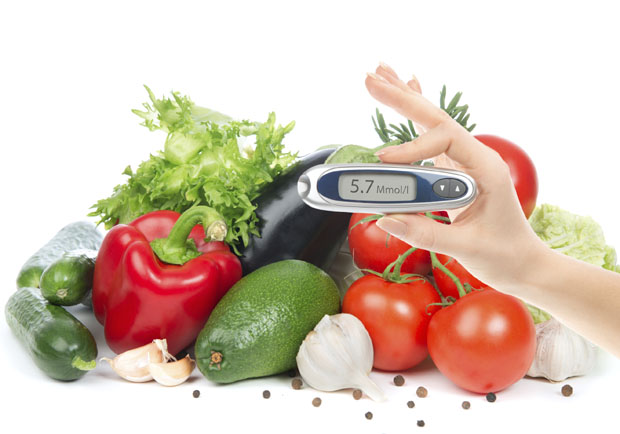Nutrition and Diabetes
04 Jul 2014
What you need to know now
By Edna Cox Rice RD, CSG, LD

Diet is essential in the prevention, treatment and control of diabetes. Many people associate diabetes with avoiding sugar, but it involves so much more than simply steering clear of sugar alone. In fact, sugar is not all bad; sugar or glucose is the body’s preferred choice of fuel for energy. Glucose is crucial for the body’s health and wellness, and provides energy to the brain, muscles and tissues. Diabetics are unable to use and metabolize sugars and starches, causing increased blood sugar levels or hyperglycemia.
Type 1 Diabetes, formerly referred to as juvenile diabetes or insulin-dependent diabetes, is a chronic condition in which the pancreas produces little or no insulin. Insulin is needed to take glucose into the body’s cells to produce energy. Type 2 Diabetes, once known as adult-onset diabetes or noninsulin-dependent diabetes, also impacts the way the body utilizes sugar. With Type 2, the body either does not produce enough insulin or resists the effectiveness of insulin. Untreated, either type of diabetes can lead to serious health consequences.
Today, 26 million Americans – children and adults – have diabetes. It is more prevalent and striking at any age; one in 400 children and adolescents has diabetes. South Carolina ranks 10th highest in the nation in the percent of population with diabetes. Diabetics are increased risk for other serious health issues such as heart disease, kidney disease, blindness and amputations.
Preventing diabetes can often be as easy as following a healthful diet and maintaining a desirable body weight. Being overweight is a primary contributor to the development of type 2 diabetes; more than 3 out of 4 diabetics are overweight. Weight loss alone can have a big impact on diabetes prevention and control; every pound of weight lost counts. Participants in one large study lost around 7 percent of their body weight and exercised regularly; they reduced the risk of developing diabetes by 60 percent. Staying at a healthy weight is a weight that is right for you. Experts now assess obesity and overweight by using body mass index (BMI). Check your BMI at www.bmi-calculator.net.
Deciding when, what and how much to eat can be a challenge for anyone, but are key to managing diabetes. There’s no such thing as a “diabetic meal plan,” but planning does make a difference. Some Tips to Remember:
- Eat at regular times
- Include foods high in fiber; eat whole-grain breads and cereals instead of refined breads, cereals and sugars
- Drink water or sugar-free beverages
- Snack on raw veggies or fruit
- At meals – cover half of your plate with vegetables; one quarter of your plate with starchy foods; one quarter with protein
- Set a goal to eat 5-9 servings of fruit and vegetables daily (other than white potatoes, corn, or peas)
- Reduce total fat intake to less than 30 percent of total calories; choose unsaturated fats rather than saturated
- Walk briskly or engage in some form of physical activity at least 30 minutes daily
Having diabetes doesn’t mean a low-carb diet or avoiding carbohydrates altogether is necessary. It’s all about balance. Research shows that many types of eating patterns can work to manage diabetes. Carbohydrates can be worked into the overall diet. Choosing healthy carbohydrate foods, eating regular meals and portion control are helpful tools to keep your carb intake consistent. When choosing carbohydrates for meals focus on fiber and portion. The best carb choices include:
- Fresh, frozen or fruit canned without added sugars
- Whole grains such as 100% whole wheat bread, brown rice, oatmeal and quinoa
- Starchy vegetables like potatoes, winter squash, pumpkin, corn, parsnips and plantains
- Beans, legumes and peas
- Non-fat dairy such as 1% milk, skim milk and non-fat yogurt
- Be vigilant about the portions
Non-starchy vegetables such as leafy greens, tomatoes, and carrots are relatively low in carbohydrate, about 5 grams in one half cup (this may vary). So including a full cup serving of any of these veggies is an excellent source of carbohydrates to include on your plate. Most important to the diabetic diet is including a variety of healthy carbohydrates.
Special diabetic foods are not necessary; diabetics can enjoy the same wide variety available to the non-diabetics. Sugary foods, like most sweets and desserts, prepared with table sugar, dextrose, corn syrup, “natural “sugars or brown sugar should be limited or avoided. It’s best to avoid sugary drinks all together and stick to zero-calorie beverages like water or unsweetened tea. Artificial sweeteners such as saccharin, aspartame and sucrolose can be an effective tool for diabetics. No sugar substitute is risk free and studies have shown they are not very effective aids for weight loss. Sensitive people have experienced a variety of symptoms when using some sugar substitutes, but used in moderation they are considered relatively safe.
Everyone, not only diabetics, should eat a healthy diet and stay physically active. Managing diabetes is a life-long responsibility. A few lifestyle changes can be big steps toward preventing or delaying diabetes and complications associated with the disease – it’s never too late to start!











